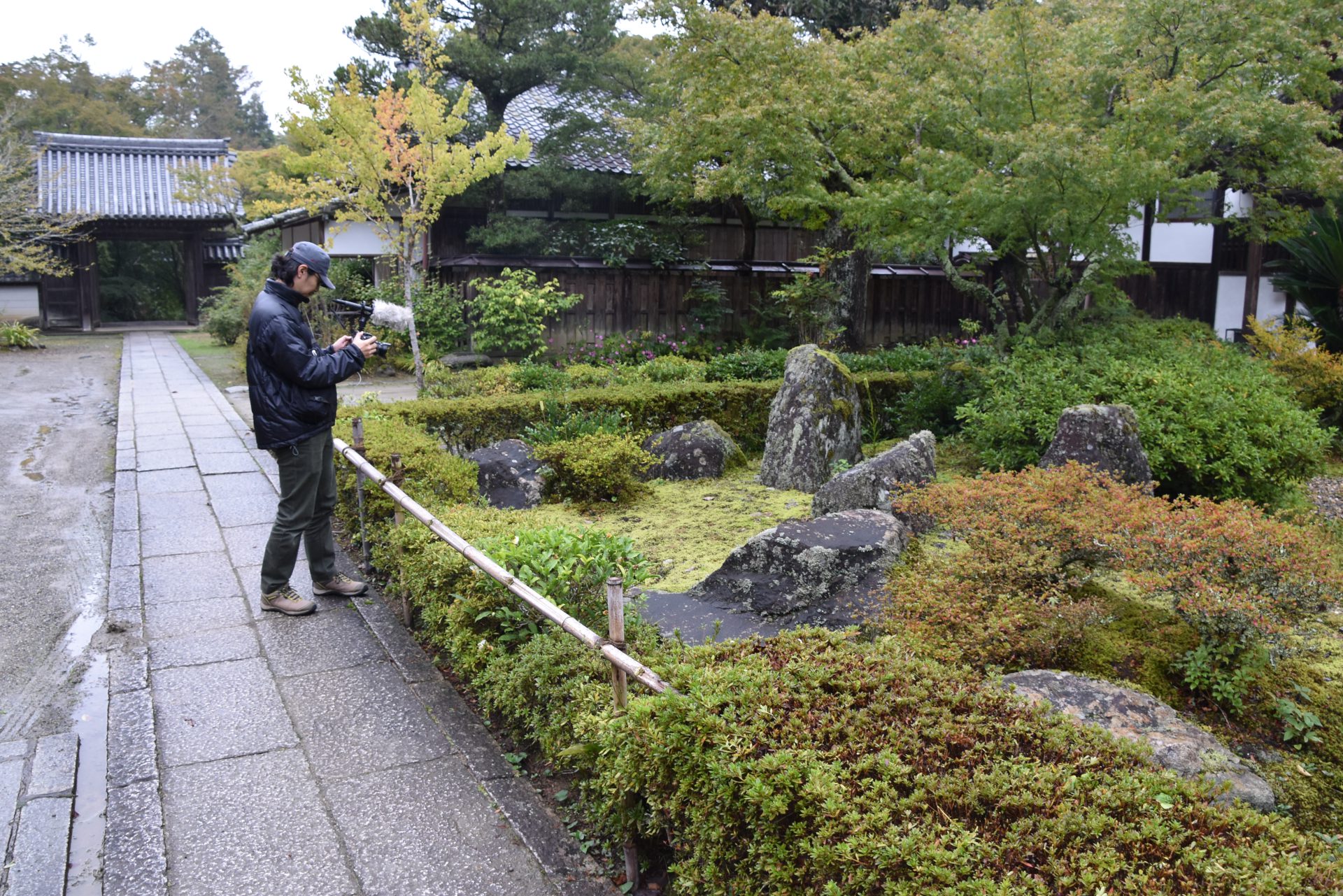2015年頃から、澤崎は芸術によるパブリックエンゲージメントの実践と研究を続けてきた。それ以前からも映像を中心とした現代美術作品の制作と発表を多数行っていたが、フランスの庭師ジル・クレマンの活動を記録した劇場公開映画『動いている庭』(監督:澤崎賢一, 85分, 2016)の制作をきっかけに、彼は総合地球環境学研究所(地球研)のフィールド研究者たちが実施する調査研究活動に同行し、東南アジアやアフリカや日本各地でのフィールド調査を記録した多くの民俗誌映画や映像教材を制作した。
フィールド研究者の調査現場では、彼ら研究者たちの主たる研究内容だけでなく、そこでこぼれ落ちてしまう知恵や工夫や驚き(=フィールドの潜在性)を現地の暮らしの中に垣間見ることができた。しかし、それらの多くは研究成果の周縁に追いやられ、主たる成果のエピソード的な記述に留められてきた。トヨタ財団の助成を受けた澤崎の個人研究では、フィールド研究者たちの研究成果の感性的な側面を、映像芸術を活かして可視化・顕在化させるための表現手法の研究が実施された。
- 澤崎賢一『「暮らしの目線」に見るフィールド研究の感性―映像メディアを活かす超学際研究の表現形の探究―』2017-2019年
https://toyotafound.secure.force.com/psearch/JoseiDetail?name=D16-R-0344
2018年には、トヨタ財団の研究成果として、地球研の「砂漠化をめぐる風と人と土」プロジェクト(2012-2016)のリーダーであった農学者・田中樹らと共に、澤崎は一般社団法人リビング・モンタージュを創設し、同法人が主催する映像メディアの学際的活用の基盤となるプラットフォーム「暮らしのモンタージュ」を発足させた。このプラットフォーム上では、異なる価値観や問いを共有する為の新たな文化的ナラティブの創造を構築するために、幅広い意味での映像イメージの可能性を活かした領域横断的な方法論を実践的に探求している。
京都市立芸術大学の博士課程における澤崎の研究では、田中樹や文化人類学者の清水貴夫らのフィールド調査の記録をもとに制作した多重層的ドキュメンタリー映画『#まなざしのかたち』(監督:澤崎賢一, 124分, 2021年)の制作工程を振り返りながら、映画的な「余白」(=鑑賞者が自分自身の経験を思い起こして思考するような時間)において、「フィールドの潜在性」を生きた資源や発見として捉え直すための手法が考察された。ここで明らかになったのは、学術研究の感性的な部分とイメージに関わる芸術表現がメタ的な視点において重なり合い、分野を横断した共創によって双方にとっての気付きや学びの場が創出されたことである。
澤崎がフィールド研究者の体験がもつ価値に新しい視座を与える自身の手法について考察した論考「暮らしのモンタージュ―フィールド研究の余白―」(対話型学術誌『といとうとい』Vol.0,京都大学学際融合教育研究推進センター, 2021)には、博士課程において論じた手法のひとつ「水平的モンタージュ」を駆使した事例として、映画『#まなざしのかたち』の一部の映像を別のバージョンとして再編集した映像作品 「#まなざしのかたち 雨上がり、水平的に、ストリートにて」(10分, 2021)が誌面にQRコードで掲載された。
2021年には、映画『#まなざしのかたち』における方法論を発展させて、さらに異なる分野の研究者、特に自然科学を専門とする研究者とのコラボレーションを模索するために、科学者とアーティストの交流を広く一般に開くプロジェクト「ファンダメンタルズ」(主催:ファンダメンタルズ プログラム)に参加した。ここで澤崎は、表面界面科学・物理化学を専門とする湊丈俊(分子科学研究所)、医用工学・人間工学を専門とする石河睦生(桐蔭横浜大学)、地理学・都市環境学を専門とする一ノ瀬俊明(国立環境研究所)らと出会い、2021年から現在に至るまで様々に交流を行ってきた。
2022年頃からは、彼ら3名の協力のもと、分子-身体-都市と異なる位相から科学者の知識生産のプロセスにおける感覚や情動に着目する共同研究プロジェクト「センサリー・ダイアローグ:アートとサイエンスの共創のための場の創出」(2022年-現在)の実施をスタートさせた。このプロジェクトでは、映像やイメージを活用して、異分野コミュニケーションにおける感覚や感情にフォーカスした試験的な対話を実践し、それら実践のプロセスを観察、考察している。2022年にJR上野駅で開催された企画展「ファンダメンタルズ フェスmini」では、各科学者たちの対話を記録した映像作品「対話の記録」を展示上映した。2023年に東京大学駒場博物館で開催された企画展「ファンダメンタルズ フェス(2021-2023)」では、各研究者の研究室を記録した映像インスタレーションを発表した。
2021年頃からは、現代社会とイスラームを専門とする文化人類学者の阿毛香絵とイスラームとジェンダーを専門とする野中葉と共に澤崎は、映像メディアを活かしたプロジェクト「ヤングムスリムの窓:芸術と学問のクロスワーク」を企画・運営している。このプロジェクトでは、ダイバーシティや多文化共生を背景に、日本に暮らすヤングムスリムたちの視点=窓を通じて日本社会はどのように映るのかを明らかにすることを目的に、ヤングムスリムたちとの協働による映像制作を通した研究、芸術実践を試みている。
ここでのヤングムスリムには、イスラーム圏出身の親を持ち日本で生まれ育った2世やイスラームに改宗した日本人など、様々なプロフィールの若者たちがいる。プロジェクトの活動を通じて、彼らヤングムスリムが宗教を実践しながら、日本で自らを取り巻く人々や社会とどのような関係性を築いているのかを明らかにすると共に、映像制作の過程における異なるアクター(研究者、当事者、撮影者、参加者等)同士のやり取りや制作プロセスそのものに焦点を当て、それを作品となる映像やメディア表現の一部として取り込みつつ評価、分析していく。
当事者参加型の本プロジェクトでは、プロジェクトのメンバーおよび参加者であるヤングムスリムたちの基本的には全員がカメラで互いを撮影し合います。また、撮影した映像素材は、コモンズ=共有資源としてクラウド上にアップロードされ、それら共有素材をもとに各自が自らの価値観や考えに基づき映像制作を進めます。本プロジェクトでは、こうして制作される映画の一群を、国立民族学博物館の国際オンラインジャーナルに掲載された査読付き論文(Kenichi Sawazaki, Kae Amo, Yo Nonaka et al. ”Emergent Use of Visual Media in Young Muslim Studies” TRAJECTORIA Vol.5, National Museum of Ethnology, Japan, 2024)にて、〈コモンズ映画〉と名付けた。
展覧会「ヤングムスリムの窓:撮られているのは、たしかにワタシだが、撮っているワタシはいったい誰だろう?」(京都精華大学サテライトスペースDemachi, 2023)とドキュメンタリー映画『#まなざしのかたち ヤングムスリムの窓』(43分30秒, 2023, マダニ国際映画祭にてプレミア上映)は、その成果の一例ですが、ここまでのところ、このプロジェクトの特徴として、当事者の発信、当事者と研究者とアートの協働、映像それ自体についてのメタ的な考察など、多様な意義を見て取ることができる。
2024年8月には、NIHU若手研究者海外派遣プログラムのサポートを受けて、アメリカのワシントンD.C.に約1ヶ月間、澤崎は共同研究を発展させるためにKLASICA(Knowledge, Learning and Societal Change Alliance)のメンバーと共に、国立標準技術研究所(NIST)やハーシュホーン・ミュージアムにて意見交換を重ねた。ワシントンD.C.での意見交換の背景には、〈メタ/コモンズ映画〉という手法が、それらが生まれたコンテクストとは全く異なるコンテクストにおいて、どのように機能しうるのか、という問いがあった。議論の成果は共著での論考「Combining Art, Sciences, and Technology in Inclusive Decision Making for Community Resilience and Sustainable Futures(アート、サイエンス、テクノロジーを組み合わせた包括的な意思決定が、コミュニティのレジリエンスと持続可能な未来を実現する)」(著者:イラン・チャバイ, ジェニファー・ヘルゲソン, デビッド・マッグス, 澤崎賢一, 未発表)にまとめられた。
